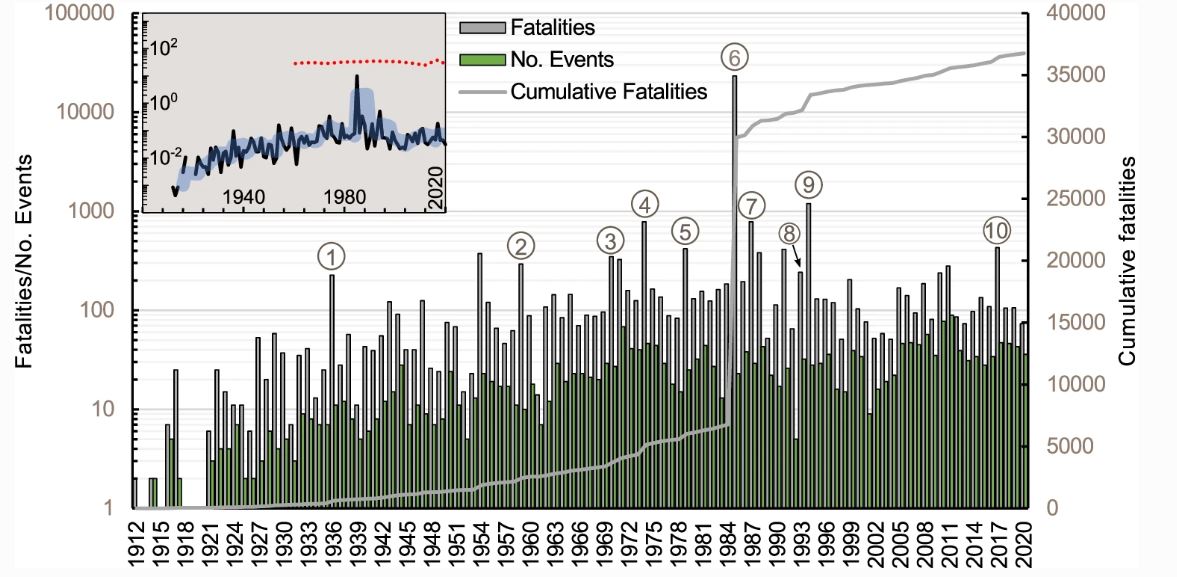7 April 2022
The long term history of fatal landslides in Colombia
Posted by Dave Petley
The long term history of fatal landslides in Colombia
Colombia is one of the most landslide-prone countries in the world. In the last few days heavy rainfall has triggered flooding and landslides, including at least one death in Marulanda Municipality in Caldas. Understanding the patterns of landslides in time and space is an important element of managing the risk in such countries.
In a paper just published in the journal Landslides (Garcia-Delgado, Petley et al. 2022), an international team has constructed a long term dataset of fatal landslides in Colombia, extending right back into historical times. This comprises 2.351 individual fatal landslides causing 37,959 fatalities. The earliest event was in October 1743, but the vast majority have been recorded since 1912, when the data becomes more robust.
The temporal pattern of the landslides in time is really interesting – this is illustrated in the graph below:-

Numbers of landslides and landslide fatalities in Colombia through time. Graph from Garcia-Delgado et al. (2022). The figure caption is: Temporal distribution of deadly landslides, their fatalities and cumulative total of fatalities from 1912 to 2020. The numbers in circles correspond to the top 10 deadliest events as follows: (1) Túquerres (9 January 1936; n = 170 fatalities); (2) Ibagué (29 June 1959; n = 250); (3) Chiriguaná (10 November 1970; n = 123); (4) Quebrada Blanca–Guayabetal (28 June 1974; n = 400); (5) El Playón (25 November 1979; n = 300); (6) Armero–Chinchiná (13 November 1985; n = 23,084); (7) Villatina–Medellín (28 September 1987; n = 562); (8) Andes (26 April 1993; n = 120); (9) Páez (6 June 1994; n = 1100); and (10) Mocoa (31 March 2017; n = 333). To check the location of these events please refer to Fig. 2. The upper-left inset shows annual fatalities normalised by the number of events.
.
This is an incredibly rich and interesting figure. Note the huge jump in the cumulative fatalities associated with the lahars caused by the Armero–Chinchiná lahars, which killed over 23,000 people). Also notable is the increase in fatalities through the period from 1912 to the 1970s. Since then the number of fatal landslides has remained high but the strong positive growth has slowed. The two decades with the highest numbers of fatalities were 2001-2010 and 2011-2020. The inset graph normalises fatalities with the population (which has grown over the study period), suggesting that the per capita rate of loss has remained about the same.
The paper looks at this data in a great deal more detail, including the role of mining and road construction in landslide trends, and also the impact of the El Nino / La Nina cycle. I will return to these themes in subsequent posts. Putting together a dataset like this is an epic job – Helbert Garcia-Delgado of the Department of Earth and Environmental Sciences at Syracuse University Servicio Geológico Colombiano, who led the research, has been brilliant.
.
Reference
Garcia-Delgado, Petley, D.N., Bermúdez, M.A. and Sepúlveda, S. 2022. Fatal landslides in Colombia (from historical times to 2020) and their socio-economic impacts. Doi: https://doi.org/10.1007/s10346-022-01870-2.


 Dave Petley is the Vice-Chancellor of the University of Hull in the United Kingdom. His blog provides commentary and analysis of landslide events occurring worldwide, including the landslides themselves, latest research, and conferences and meetings.
Dave Petley is the Vice-Chancellor of the University of Hull in the United Kingdom. His blog provides commentary and analysis of landslide events occurring worldwide, including the landslides themselves, latest research, and conferences and meetings.
Observational bias, due to underreporting of events prior the digital era (circa 1970s) an unspoken factor in studies such as this. You can see this in the normalised data.
[As with all studies of this type, this issue is considered in the text. D.]